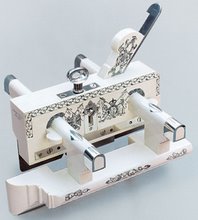 This is a group of chair scrapers I made over the years. The one in the front was the only one I did in quantity, they were made of cocobolo and had the locking screws coming from the rear into the front brass blade retainer and sole.These chair scrapes usually perform best with a .010 to .015 thick blade. I remember doing a scraper demonstration for a woodworkers club in Raleigh ,NC one year and with this chair scrape I drew it down the edge of a piece of curly maple, The shaving shot out of the throat opening vertical for about 5 inches before falling forward. An elderly gentleman at the rear of the room sprang up from his seat and yelled "can you do that again". I did.
This is a group of chair scrapers I made over the years. The one in the front was the only one I did in quantity, they were made of cocobolo and had the locking screws coming from the rear into the front brass blade retainer and sole.These chair scrapes usually perform best with a .010 to .015 thick blade. I remember doing a scraper demonstration for a woodworkers club in Raleigh ,NC one year and with this chair scrape I drew it down the edge of a piece of curly maple, The shaving shot out of the throat opening vertical for about 5 inches before falling forward. An elderly gentleman at the rear of the room sprang up from his seat and yelled "can you do that again". I did.  Not being able to afford the overpriced Stanley 69 beader I copied one from an original a customer brought into the shop for repair. About 100 were cast in silicone bronze with cocobolo handles. This was a sterling casting hand engraved with ebony handle. I keep it ,the wife said she liked it.
Not being able to afford the overpriced Stanley 69 beader I copied one from an original a customer brought into the shop for repair. About 100 were cast in silicone bronze with cocobolo handles. This was a sterling casting hand engraved with ebony handle. I keep it ,the wife said she liked it. Three stringing routers or scratch stock tools used for beading or grooving the stock to receive a thin boxwood inlay.
Three stringing routers or scratch stock tools used for beading or grooving the stock to receive a thin boxwood inlay.The front one is my design patterned after a large panel gauge. I wanted a larger head for stability in longer stock. The middle one was an English slitting gauge with a modified cutter to enable you to use it across the grain instead of with the grain.
Rear is a Stanley marking gauge modified to secure an inlay scratch blade or a beading blade.,

Close up of scratch blade for doing inlays. Blade was made from a piece of scraper blade or saw blade ,sharpened slowly ,tested to ensure the groove scratched would receive the inlay with a snug fit before gluing.

Close up of cutter installed in the English slitting gauge. It has two knife blades followed by a small scraper . When using the tool you roll the stem allowing the two knife blades to score the wood and the small scraper pulls the stock out without any tear out. It is a little tricky until you develop a feel for the rocking motion. Operation is similar to a dado plane with nickers.






No comments:
Post a Comment